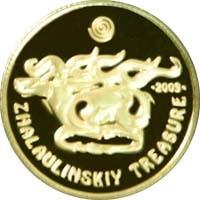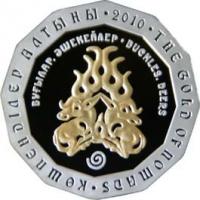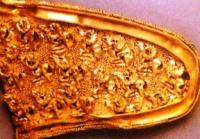You are here
Zhalaulinsky treasure.




Kazakhstan History Tour.
"The warm wind blows softly,
Fresh life breathes the steppe,
And the mounds turn green
The runaway chain"
Fet Afanasy Afanasyevich.
Tours to Ancient monuments in Kazakhstan.
Zhalaulinsky treasure got its name by the name of a small aul 200 km away. east of Almaty. All things lay in a felt bag, which was buried in the ground at the beginning of the XXth century. Among more than two hundred objects with a total weight of more than one and a half kilograms, the details of the typesetting belt, the decoration of clothes and headgear, as well as the pectoral-chest decoration stand out.The pectoral is a massive oval-shaped plate, decorated at the edges with a curb of twisted gold drota - wire.
At its ends, loops for hanging were preserved. The surface of the pectorals is decorated with miniature figurines of mountain rams brazed in 4 rows, argali, made in the “with legs crossed” pose typical of Saka art.
On the bodies of rams there are nests for strengthening colored stones - turquoise, cornelian or others, which were supposed to “break” the uniform yellow surface of the pectoral. Plaques from the typesetting belt are made in the form of tonsils.
The front surface was plaque, and they were attached to the belt in pairs, forming a circle, decorated like a pectoral, figures of argali and grain - soldered balls of gold. The details of the belt, which "hid" its leather base, include rectangular holders ornamented with a herringbone pattern.
The headdress includes plaques in the form of paired figures of deer with branched tree-like horns. Two cast plates with deer have another image of a flying eagle. The treasure has stamped plaques depicting a leopard tormenting a goat, as well as mountain goats carved from sheet gold, depicted in the "flying gallop" pose.
Interesting massive triangular plates with solders in the form of wool. Their purpose is not clear, but most likely it is a decoration of clothes. A lot of gold cone-shaped pendants that once adorned clothes and a hat.
Important for dating the entire treasure are plaques with deer, large and small. We analyze one of them. The plaque is made of fine gold, its weight is 6.15 g, maximum dimensions are 31 x 25 mm. The plaque has a sub-triangular heart-shaped shape formed by the outer outline of the animal’s figures and horns, while it is slightly asymmetrical: one deer is located slightly higher than the other.
It is made using the wax casting technique, followed by a side job with a cutter. On the reverse side of the plaque, in the area of the deer croup, there were two flat loops located at an angle to each other. A feature of modeling deer figures is the widespread use of through gaps: openings, holes denote the eye, ear, nostril, mouth, and cutting the horns of animals.
The coracoid form of the comma has gaps on the deer’s shoulder and buttock; in addition, they are used in modeling the legs of animals. We can conclude that the gaps could be closed by inserts from another material, for example, turquoise, in order to give the thing a greater decorative effect - two or multicolor.
However, the following option is not excluded: the plaque on the inside was covered with tinted mastic, which, after drying and polishing, filling the gaps, could resemble a decorative stone. And finally, the last option: the gaps were not specially closed by anything, but thanks to the tinting of the base to which the plaque was attached, and the play of chiaroscuro that arose in the gaps due to the relief of the surface of the plaque, the image was polychromic (two-color).
Analogies of this iconographic variation dating from the beginning of the VI - V centuries. BC. occur from Altai and the Minusinsk depression, allows dating the considered plaque of the Vth century. BC. The rest of the products from the Zhalauly treasure, which is a set of jewelry of the costume of the representative or representative of the Saka aristocracy, belong to the same time.
Authority:
"Monuments of Central Asia." Author M. Khashimov. Saga Publishing House, 2001 www.farsah.kz. "Ancient Kazakhstan" Arias, Saki, Huns, Turks. Children's Encyclopedia of Kazakhstan. Almaty, 2007, Aruna Publishing House. Medoev A.G.,. Magauin M. Alphabet of Kazakh history. Documentary narration. Almaty, "Kazakhstan", 1997.







